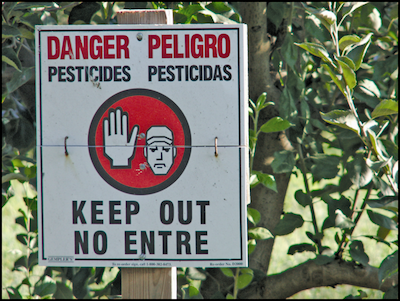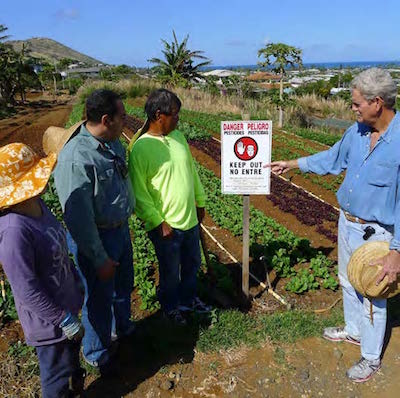Agricultural employers must not direct or allow anyone, other than trained and equipped pesticide handlers, to enter a treated area during a pesticide application. The agricultural employer must inform workers about treated area with entry-restrictions on the establishment if they are expected to walk within 1/4 mile while working.
If the pesticide label requires verbal warnings and/or posted signs, it overrides any other requirements in the WPS. The label is the law!
Requirements for Pesticide Products Without Label-Specified Notification
| Treated Site | Restricted-Entry Interval | Post Warning Sign | Verbal Warning OR Post Warning Sign |
|---|---|---|---|
| Outdoor | >48 hours | X | |
| Outdoor | ≤48 hours | X | |
| Enclosed space | >4 hours | X | |
| Enclosed space | ≤4 hours | X |
What should warning signs look like?

The requirements for the posted warning signs have not changed since 1992. Signs must include:
- A white background
- The words "DANGER" and "PELIGRO", "PESTICIDES" and "PESTICIDAS" at the top of the sign
- The words "KEEP OUT" and "NO ENTRE" at the bottom of the sign
- All letters must be clearly legible
- A circle containing an upraised hand on the left and a stern face on the right must be near the center of the sign. The inside of the circle must be red with the hand and a large portion of the face must be in white. The length of the hand must be at least twice the height of the smallest letters. The length of the face must be only slightly smaller than the hand.
The agricultural employer may replace the Spanish language portion of the warning sign with equivalent terms in an alternative non-English language if that alternative language is the language read by the largest group of workers at that agricultural establishment.
See the list below for warning signs available in other languages.
- English-Cambodian
- English-Chinese
- English-Haitian-Creole
- English-Ilocano
- English-Korean
- English-Laotian
- English-Spanish
- English-Tagalog
- English-Thai
- English-Vietnamese
When should signs be posted?
- Posted prior to the scheduled application, but not more than 24 hours before.
- Remain posted during the application and any restricted-entry interval
- Removed or covered within 3 days of the application or REI ending, whichever is later
If an agricultural employer leaves the warning signs in place, the area must be treated as if it was under an REI. Workers must not enter, with limited exceptions. It is important to make sure the warning signs are never ignored.
Where should signs be posted?

Warning signs posted in an outdoor production area using the standard sign must be visible from all reasonably expected points of worker entry to the treated area. This includes at least each access road, each border with any worker housing area within 100 feet of the treated area, and each footpath and other walking routes that enter the treated area. Where there are no reasonably expected points of worker entry, signs must be posted in the corners of the treated area or in any other location that gives maximum visibility.
For enclosed space production areas standard warning signs should be posted so they are visible from all reasonably expected points of entry to the structure or space, including each aisle or other walking route that enters the treated area.
Is there a minimum size for warning signs?
Yes. The standard sign must be at least 14 inches by 16 inches (14" x 16") with letters one inch high. The WPS allows smaller warning signs to be used to provide flexibility in situations where a smaller sign is more appropriate.
Smaller warning signs may be used as long as the following conditions are met:
If the warning sign has 7/8 inch high letters for "DANGER" and "PELIGRO", then the sign must have:
- All remaining letters at least 1/2 inch high, and
- A red circle that is at least 3 inches in diameter with the upraised hand and stern face.
If the warning sign has 7/16 inch high letters for "DANGER" and "PELIGRO", then the sign must have:
- All remaining letters at least 1/4 inch high, and
- A red circle that is at least 1 1/2 inches in diameter with the upraised hand and stern face.
Learn more:
Central Posting Materials – Informing Workers About Agricultural Pesticides


